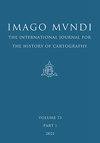旧地图上的西班牙。罗德里格斯·托雷斯-阿尤索系列目录
IF 0.5
4区 历史学
Q4 GEOGRAPHY
Imago Mundi-The International Journal for the History of Cartography
Pub Date : 2022-07-03
DOI:10.1080/03085694.2022.2130549
引用次数: 0
摘要
所谓的保利斯塔人,来自圣保罗-德-皮拉蒂尼加高原的卢索-巴西混血儿,在寻找土著人口作为奴隶的过程中超越了当代条约规定的界限,甚至到达了西班牙耶稣会传教团。17世纪末,在南美洲中部发现了金矿和祖母绿矿。到17世纪40年代,在黄金开采的高峰期,黄金产量达到了14吨,这加速了对更明确地确定每个王室财产的条约的需求。Goes通过探讨保利斯塔的主题,深入探讨了巴西史学中的一个棘手问题。二十世纪亚历山大·德·古斯芒著作复兴过程中最重要的人物之一是葡萄牙学者海梅·科尔特斯ão(1884-1960),他除了认为葡萄牙王室对葡萄牙在南美洲的向西扩张负有主要责任外,由于其领土的地缘政治重要性,这有助于混淆保利斯塔在这一过程中所扮演角色的形象。然而,大多数巴西史学倾向于质疑保利斯塔对巴西空间建设的看法,尤其是从更好地了解他们在掠夺奴隶以供应巴西高地奴隶市场的过程中在腹地的运动。边界神话是谈判桌上领土合法化的关键因素。因此,Goes在质疑Cortesão的一些论点时,讨论了两个主要的神话。首先是巴西岛,这一概念在18世纪借助上个世纪的地图被广泛使用。根据这个神话,Plate河和Amazon河的流域在大陆中心的某个地方交汇,形成了巨大的Xarayes湖,葡萄牙领土已经被“自然边界”与西班牙隔开。第二个神话表明,今天组成巴西的领土以前属于一个庞大的土著图皮-瓜拉尼人群体,从巴拉圭河和瓜波雷河交汇处到亚马逊的整个地区都是他们的祖先领地:品多拉玛。对这两个神话都提出了质疑,指出边界是人类从特定时期开始构建的,并表明了亚历山大·德·古斯芒作为外交谈判中两个关键要素的代言人的重要性:实际占有权的概念,即保证已经在这片土地上殖民的人的合法占有权,以及领土占有将以河流和山脉等自然景观元素为标志的想法。因此,在Goes看来,巴西领土作为一个地理实体,在很大程度上要归功于Alexandre de Gusmão所发挥的作用。但在关注古斯芒时,他几乎在叙述中留下了一个重要的考虑因素,即葡属美洲的实际勘探事件。地图的构建及其在外交中的使用也依赖于重要启蒙网络中的信息流通,这使得整个过程更加复杂。然而,在关注神话和空间问题并将其确定为历史过程的过程中,Goes向我们展示了使用古斯芒在20世纪的思想并将古斯芒本人变成神话的危险。©Antonio JoséAlves de Oliveira Instituto Nacional da Mata Atlâtica Santa Teresa,Espírito,巴西http://orcid.org/0000-0001-5019-5983https://doi.org/10.1080/03085694.2022.2130547本文章由计算机程序翻译,如有差异,请以英文原文为准。
España en Mapas Antiguos. Catálogo de la Colección Rodríguez Torres–Ayuso
the so called paulistas, luso-brazilian mestizos from the plateau of São Paulo de Piratininga, had overstepped the lines imposed by contemporary treaties in their search for indigenous populations to use as slaves, even reaching the Spanish Jesuit missions. At the end of the seventeenth century, gold and emerald mines were found in the centre of South America. By the 1740s, at the peak of extraction, production reached 14 tons of gold, accelerating the need for treaties that would determine more clearly the possessions of each Crown. By approaching the topic of the paulistas, Goes delves into a thorny issue in Brazilian historiography. One of the most important figures in the revival of Alexandre de Gusmão’s writings in the twentieth century was the Portuguese scholar Jaime Cortesão (1884–1960), who, in addition to understanding the Portuguese Crown as being chiefly responsible for Portugal’s westward expansion in South America, thanks to the geopolitical importance of its territories, helped to mystify the image of the role of the paulistas in this process. Most Brazilian historiography, though, tends to question the paulista view of the construction of Brazilian space, especially from a better understanding of their movement in the hinterland in the course of slave raiding to supply the slave markets in the Brazilian Highland. Border myths are crucial elements in the legitimation of territories at the negotiating table. Thus, questioning some of Cortesão’s theses, Goes discusses two of the main myths. First, that of Brazil Island, an idea widely used in the eighteenth century with the help of maps from the previous century. According to this myth, the basins of the rivers Plate and Amazon met at some point in the centre of the continent, forming the immense Xarayes Lake, in such a way that the Portuguese territories were already separated from the Spanish by ‘natural borders’. The second myth suggested that the territories that today make up Brazil formerly belonged to an immense indigenous Tupi-Guarani group and that the whole area from the confluence of the Paraguay River and the Guaporé River to the Amazon was their ancestral territory: Pindorama. Goes questions both myths, pointing to borders as human constructs from a given time and showing the importance of Alexandre de Gusmão as an articulator of two key elements in the diplomatic negotiations: the idea of utis possidetis, by which legitimate possession was guaranteed to those who had already colonized the land, and the idea that territorial possession would be marked by natural landscape elements such as rivers and mountain chains. Thus, in Goes’s view, Brazilian territory as a geographical entity owes much to the role played by Alexandre de Gusmão. But in focusing on Gusmão, he almost leaves an important consideration out of his narrative, namely that of the actual events of exploration in Portuguese America. The construction of maps and their use in diplomacy were also dependent on the circulation of information in important Enlightenment networks, making the whole process muchmore complex. Nevertheless, in focusing on questions about mythologies and space, and identifying them as historical processes, Goes has shown us the dangers of using, for example, Gusmão’s ideas in the twentieth century and turning Gusmão himself into a myth. © Antonio José Alves de Oliveira Instituto Nacional da Mata Atlântica Santa Teresa, Espírito, Brazil http://orcid.org/0000-0001-5019-5983 https://doi.org/10.1080/03085694.2022.2130547
求助全文
通过发布文献求助,成功后即可免费获取论文全文。
去求助
来源期刊
CiteScore
0.20
自引率
0.00%
发文量
32
期刊介绍:
The English-language, fully-refereed, journal Imago Mundi was founded in 1935 and is the only international, interdisciplinary and scholarly journal solely devoted to the study of early maps in all their aspects. Full-length articles, with abstracts in English, French, German and Spanish, deal with the history and interpretation of non-current maps and mapmaking in any part of the world. Shorter articles communicate significant new findings or new opinions. All articles are fully illustrated. Each volume also contains three reference sections that together provide an up-to-date summary of current developments and make Imago Mundi a vital journal of record as well as information and debate: Book Reviews; an extensive and authoritative Bibliography.

 求助内容:
求助内容: 应助结果提醒方式:
应助结果提醒方式:


